
A gravitational lens is matter, such as a cluster of galaxies or a point particle, that bends light from a distant source as it travels toward an observer. The amount of gravitational lensing is described by Albert Einstein's general theory of relativity. If light is treated as corpuscles travelling at the speed of light, Newtonian physics also predicts the bending of light, but only half of that predicted by general relativity.

A galaxy cluster, or a cluster of galaxies, is a structure that consists of anywhere from hundreds to thousands of galaxies that are bound together by gravity, with typical masses ranging from 1014 to 1015 solar masses. They are the second-largest known gravitationally bound structures in the universe after some superclusters (of which only one, the Shapley Supercluster, is known to be bound). They were believed to be the largest known structures in the universe until the 1980s, when superclusters were discovered. One of the key features of clusters is the intracluster medium (ICM). The ICM consists of heated gas between the galaxies and has a peak temperature between 2–15 keV that is dependent on the total mass of the cluster. Galaxy clusters should not be confused with galactic clusters (also known as open clusters), which are star clusters within galaxies, or with globular clusters, which typically orbit galaxies. Small aggregates of galaxies are referred to as galaxy groups rather than clusters of galaxies. The galaxy groups and clusters can themselves cluster together to form superclusters.

An Einstein ring, also known as an Einstein–Chwolson ring or Chwolson ring, is created when light from a galaxy or star passes by a massive object en route to the Earth. Due to gravitational lensing, the light is diverted, making it seem to come from different places. If source, lens, and observer are all in perfect alignment (syzygy), the light appears as a ring.

The Einstein Cross is a gravitationally lensed quasar that sits directly behind the centre of the galaxy ZW 2237+030, called Huchra's Lens. Four images of the same distant quasar appear in the middle of the foreground galaxy due to strong gravitational lensing. This system was discovered by John Huchra and coworkers in 1985, although at the time they only detected that there was a quasar behind a galaxy based on differing redshifts and did not resolve the four separate images of the quasar.

Abell 1689 is a galaxy cluster in the constellation Virgo over 2.3 billion light-years away.
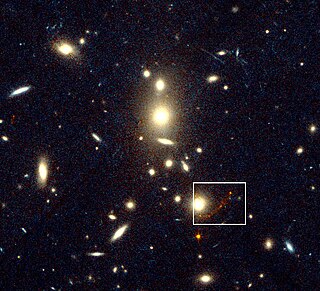
CL 1358+62 is a galaxy cluster located at z=0.33 redshift. Behind the cluster, lensed into a red arc is an infant galaxy that was the farthest object in the observable universe for a few months. It had a record redshift of z=4.92 and was discovered on July 31, 1997 by M. Franx and G. Illingsworth. It is located approximately 26 billion light years from Earth. Its redshift was measured by the Keck Telescope shortly after its discovery. Along with G1, another galaxy also lensed, was found to be at z=4.92. The pair of galaxies were the first things other than quasars to have the title of most distant object found, since the 1960s. The pair of galaxies remained the most distant objects known until the discovery of RD1 at z=5.34, the first object to exceed redshift 5.

The Comet Galaxy, a spiral galaxy located 3.2 billion light-years from Earth, in the galaxy cluster Abell 2667, was found with the Hubble Space Telescope. This galaxy has slightly more mass than our Milky Way. It was detected on 2 March 2007.
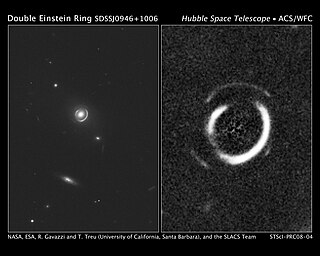
SDSSJ0946+1006 is an unusual gravitational lens system consisting of three galaxies at distances of respectively three, six, and eleven billion light years from Earth. In a report presented at the 211th meeting of the American Astronomical Society, researchers Raphael Gavazzi and Tommaso Treu of the University of California, Santa Barbara described the discovery of a double Einstein ring produced by the gravitational lensing of light from two distant galaxies. The observations were made using the Hubble Space Telescope.
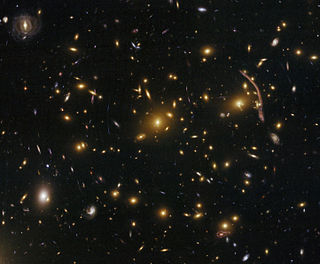
Abell 370 is a galaxy cluster located nearly 5 billion light-years away from the Earth, in the constellation Cetus. Its core is made up of several hundred galaxies. It was catalogued by George Abell, and is the most distant of the clusters he catalogued.

The Cloverleaf quasar is a bright, gravitationally lensed quasar. It receives its name because of gravitational lensing spitting the single quasar into four images.

MACS0647-JD is a galaxy with a redshift of about z = 10.7, equivalent to a light travel distance of 13.26 billion light-years. If the distance estimate is correct, it formed about 427 million years after the Big Bang.

The Cluster Lensing And Supernova survey with Hubble (CLASH) was a program on the Hubble Space Telescope to observe 25 massive galaxy clusters. CLASH was one of three programs selected in the first class of Hubble multi-cycle treasury programs, which were designed to tackle large questions unanswerable through normal observations. Observations for CLASH were conducted between November 2010 and July 2013. CLASH was led by principal investigator Marc Postman, and had a science team of over 40 researchers.

J1000+0221 was the most distant gravitational lens galaxy known, and remains the most distant quad-image lens galaxy discovered so far. The measured distance the light has traveled, including the lensed deflection, is 9.4 billion light years. A very recent discovery by a group of astronomers led by Dr Arjen Van der Wel from the Max Planck Institute for Astronomy in Heidelberg, Germany, the results of which are accepted for publication on October 21, 2013 in the Astrophysical Journal Letters (arXiv.org). Using NASA’s Hubble Space Telescope, the astronomers discovered this quadruple gravitational lens dubbed J1000+0221 which would provide a further test for Einstein's theory of general relativity. These gravitational lenses also serve as light magnification tools that help astronomers to look at distant galaxies thus acting as a natural telescope.
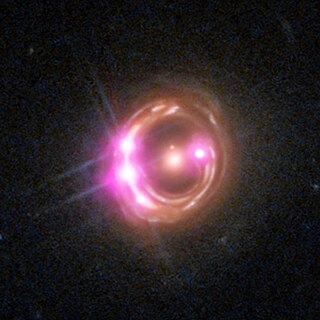
RX J1131-1231 is a distant, supermassive-black-hole-containing quasar located about 6 billion light years from Earth in the constellation Crater.

The galaxy cluster IRC 0218 hosts the most distant strong gravitational lensing galaxy currently known at a redshift of z = 1.62. The lens is one of the two brightest cluster galaxies and is lensing a background star-forming galaxy at a redshift of z = 2.26 into a bright arc and a faint counterimage. The lens was discovered through a combination of Hubble Space Telescope and Keck telescope imaging and spectroscopy. The discovery and subsequent analysis of the lens was published in the Astrophysical Journal Letters on June 23, 2014 by an international team of astronomers led by Dr. Kim-Vy Tran from Texas A&M University in College Station, Texas and team members Dr. Kenneth Wong and Dr. Sherry Suyu from the Academia Sinica Institute of Astronomy and Astrophysics in Taipei, Taiwan.

MACS J0416.1-2403 or MACS0416 abbreviated, is a cluster of galaxies at a redshift of z=0.397 with a mass 160 trillion times the mass of the Sun inside 200 kpc (650 kly). Its mass extends out to a radius of 950 kpc (3,100 kly) and was measured as 1.15 × 1015 solar masses. The system was discovered in images taken by the Hubble Space Telescope during the Massive Cluster Survey, MACS. This cluster causes gravitational lensing of distant galaxies producing multiple images. Based on the distribution of the multiple image copies, scientists have been able to deduce and map the distribution of dark matter. The images, released in 2014, were used in the Cluster Lensing And Supernova survey with Hubble (CLASH) to help scientists peer back in time at the early Universe and to discover the distribution of dark matter.

SN Refsdal is the first detected multiply-lensed supernova, visible within the field of the galaxy cluster MACS J1149+2223. It was named after Norwegian astrophysicist Sjur Refsdal, who, in 1964, first proposed using time-delayed images from a lensed supernova to study the expansion of the universe. The observations were made using the Hubble Space Telescope.
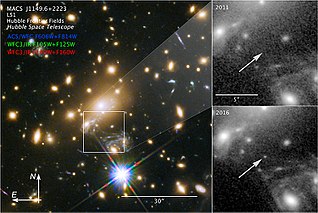
MACS J1149 Lensed Star 1, also known as Icarus, is a blue supergiant star observed through a gravitational lens. It is the seventh most distant individual star to have been detected so far, at approximately 14 billion light-years from Earth. Light from the star was emitted 4.4 billion years after the Big Bang. According to co-discoverer Patrick Kelly, the star is at least a hundred times more distant than the next-farthest non-supernova star observed, SDSS J1229+1122, and is the first magnified individual star seen.

WHL0137-LS, also known as Earendel, is a star located in the constellation of Cetus. Discovered in 2022 by the Hubble Space Telescope, it is the earliest and most distant known star, at a comoving distance of 28 billion light-years. The previous furthest known star, MACS J1149 Lensed Star 1, also known as Icarus, at a comoving distance of 14.4 billion light-years, was discovered by Hubble in 2018. Stars like Earendel can be observed at cosmological distances thanks to the large magnification factors afforded by gravitational lensing, which can exceed 1,000. Other stars have been observed through this technique, such as Godzilla.

SMACS J0723.3–7327, commonly referred to as SMACS 0723, is a galaxy cluster about 4 billion light years from Earth, within the southern constellation of Volans. It is a patch of sky visible from the Southern Hemisphere on Earth and often observed by the Hubble Space Telescope and other telescopes in search of the deep past. It was the target of the first full-color image to be unveiled by the James Webb Space Telescope (JWST), imaged using NIRCam, with spectra included, showing objects lensed by the cluster with redshifts implying they are 13.1 billion years old. The cluster has been previously observed by the Hubble Space Telescope (HST) as part of the Southern MAssive Cluster Survey (SMACS), as well as Planck and Chandra.


















